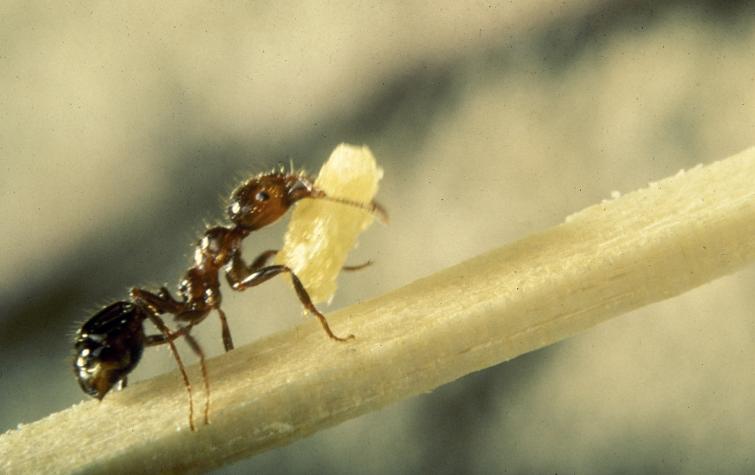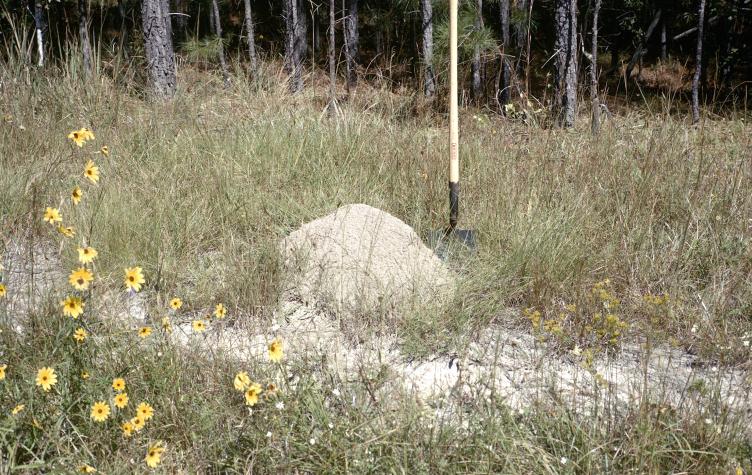COLUMBIA, Mo. – Missouri farmers who bought hay from parts of the southern U.S. may have accidentally brought along a nasty visitor.
The imported fire ant, an aggressive, stinging insect native to South America, has infested more than 380 million acres in at least 13 states, according to the USDA’s Animal and Plant Health Inspection Service (APHIS). The ants can spread to new locations as stowaways in bales of hay.
“The increased trade and transport of hay into Missouri over the last few years has increased the risk of the pest being transported into the state,” said Brian Deschu, APHIS domestic program coordinator in Jefferson City, Mo.
“I’ve been concerned about fire ants getting here since I came to Missouri in 2000,” said Richard Houseman, University of Missouri Extension entomologist. Houseman studied for his doctorate at Texas A&M University, right in the heart of the “Fire Ant Belt.” In some parts of the South, fire ant colonies are so widespread that residents learn to be careful where they step.
Imported fire ants were inadvertently introduced to this country about a century ago. Free of the natural predators that kept them in check in South America, imported fire ants have become a significant pest throughout much of the southern United States.
The ants are reddish-brown or black in color and are 1/8- to 1/4-inch long, according to APHIS.
“Imported fire ants are a minor threat to agricultural crops, but are a bigger threat to the landscaping, nursery and sod industries,” Houseman said. “They have a major impact in residential areas. They produce unsightly mounds, enter residential structures and deliver a potent sting when they are threatened or disturbed.”
Imported fire ants disrupt natural ecosystems by displacing beneficial native insects and killing small mammals, reptiles and ground-nesting birds, he said.
When threatened, they can attack en masse, repeatedly jabbing victims with their venom-filled stingers. The venom produces an acute burning sensation—hence the name “fire ant”—followed by the formation of itchy or painful white pustules that may take days to disappear.
APHIS is enforcing a federal quarantine that regulates the transport of certain items, including baled hay that has been in direct contact with the ground, soil, grass sod and soil-moving equipment. Regulated items cannot be moved outside the quarantine area unless certified by federal or state inspectors.
The quarantine area includes all of Alabama, Florida, Georgia, Louisiana, Mississippi, South Carolina and Puerto Rico; large portions of Arkansas, North Carolina, Tennessee and Texas; and small parts of California, New Mexico and Oklahoma.
Houseman said southern Missouri is at risk because of its proximity to existing imported fire ant infestations and a climate congenial to imported fire ants, particularly in the Bootheel region.
Imported fire ant colonies build distinctive foot-high mounds that can damage vehicles and farm equipment. Underground colonies can undermine sidewalks, roads and bridges, inflicting extensive and costly damage, he said.
The ants also have a mysterious attraction to electrical equipment, Houseman said. They will nest in circuit breakers, air conditioners and similar items. They have shorted out traffic signals and disrupted power in buildings. According to a study at Texas Tech University, fire ant damage to electrical and communications equipment in that state totals hundreds of millions of dollars annually.
“This would have a bigger impact than the emerald ash borer's arrival in Missouri,” Houseman said, referring to the beetle that has killed millions of ash trees in Michigan and was found in southeastern Missouri in 2008.
While the deaths of millions of urban ash trees in Missouri’s cities and towns would have a significant economic impact, widespread infestations of imported fire ants would affect everything from agriculture and municipal infrastructure to public safety and everyday life, he said.
If you suspect the presence of imported fire ants, Houseman recommends contacting your local MU Extension center or MU Extension’s Plant Diagnostic Clinic at 573-882-3019. See plantclinic.missouri.edu for more information.
You can find out if a particular location is under quarantine through the APHIS Web site by viewing a quarantine map at aphis.usda.gov/plant-pests-diseases/ifa. The site contains extensive information about imported fire ants, including guidelines for producers and purchasers of baled hay.
###
APHIS recommendations
APHIS suggests hay buyers follow these practices to help reduce infestations:
-Visually inspect the bales on delivery.
-If possible, request the hay be certified for movement by the state from which it is shipped.
-If you suspect infestation, place bait such as a dab of peanut butter or a piece of sausage on the bale and check for ants after an hour.
###

